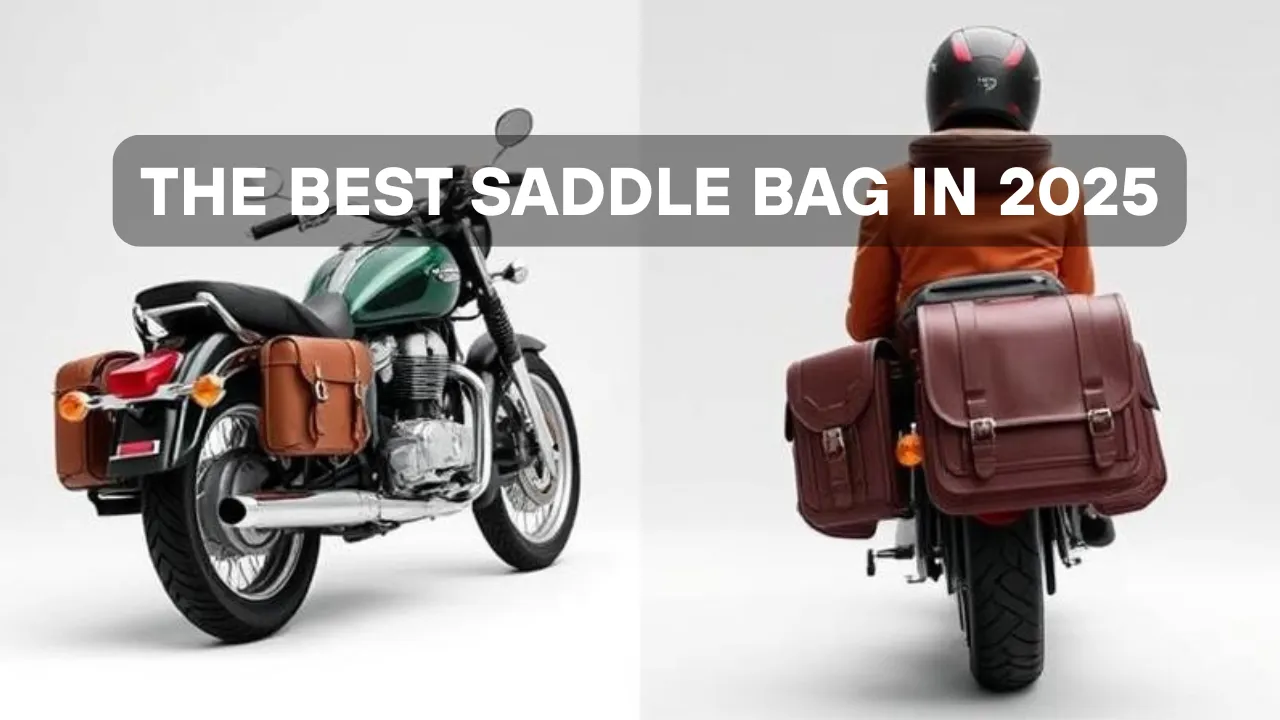The Best Saddle Bag in 2025
Introduction
Choosing the right saddle bag is essential for both comfort and convenience, whether you’re cycling for sport, commuting, or leisure. A well-chosen saddle bag helps organize your essentials, ensuring they stay secure and accessible. Key features to consider include material durability, size, and the mounting system. A waterproof design is crucial for wet conditions, while adjustable straps and sufficient capacity ensure a snug fit and ample storage. By understanding these features, you can select a saddle bag that meets your cycling needs, enhancing both performance and enjoyment on every ride.
Understanding the Different Types of Saddle Bags
When choosing a bag, it’s important to understand the key differences between cycling-specific saddle bags and fashion saddle bags.

Cycling-Specific Saddle Bags
Designed for performance and practicality, cycling-specific bags are built to withstand the rigors of cycling. These bags are typically smaller, lightweight, and designed to hold only the essentials, like tire repair tools, a spare tube, and a mini pump. Their materials often include waterproof or water-resistant fabrics to protect your gear from the elements. The design is focused on functionality, featuring secure mounting systems that keep the bag in place during long rides.
Fashion Saddle Bags
On the other hand, fashion bags prioritize style over function. These bags are more spacious and are ideal for daily use, like commuting or running errands. They often feature more fashionable details such as leather, unique shapes, or bold colors. While some may still offer functional storage, they are less likely to have the durability or weatherproofing necessary for serious cycling.
Key Differences in Design, Capacity, and Functionality
Cycling saddle bags are typically compact and streamlined, designed to minimize weight and maximize efficiency. The capacity is just enough to carry essentials for a ride, with options ranging from small bags for short trips to larger models for longer rides.
In contrast, fashion bags are usually larger with more pockets and compartments. They can carry a variety of personal items, including keys, wallets, and even a phone, making them great for day-to-day use but less suited for cycling performance.
In short, if you’re a dedicated cyclist, a cycling-specific bag will provide the durability, weather resistance, and practical storage you need. However, if you’re looking for an accessory that pairs well with your casual outfits while still offering some storage, a fashion bag is a good choice.
Key Features to Look
When selecting the perfect bag, there are several key features that can make a significant difference in its performance, durability, and overall usability.

Material & Durability
A high-quality bag must be durable enough to withstand the elements, especially if you frequently cycle in wet or muddy conditions. Waterproof materials like ripstop nylon or PU-coated fabrics are essential to keep your gear dry. Look for bags that have sealed seams or waterproof zippers to enhance protection. Abrasion-resistant fabrics are another must-have, especially if you often cycle through rough terrain where your bag may scrape against rocks or branches.
Size & Capacity
Size plays a huge role in determining the functionality of a bag. For short rides, a small bag that can carry just a tube, tire levers, and a mini pump is perfect. However, for longer rides or multi-day trips, you may need a bag with a larger capacity to accommodate more tools, snacks, or even a light jacket. Make sure the bag is compact enough not to affect your aerodynamics or comfort but large enough to carry the necessary gear for your ride.
Mounting System & Security
The way a bag attaches to your bike is crucial for both security and convenience. A hook-and-loop mounting system (Velcro) is common, offering a secure fit and adjustable sizing. Click-on systems, which use a hard attachment mechanism, provide added security and are easier to remove, making them ideal for riders who need to quickly detach their bag. Look for bags with stabilizing straps that prevent shifting during rides, ensuring your bag stays in place no matter how bumpy the ride gets.
Top Brands for Saddle Bags
Choosing a bag from a reputable brand ensures that you’re getting a high-quality product built to last. Several top brands are well-known for producing reliable, durable saddle bags.

Ortlieb
Ortlieb is one of the leading brands when it comes to high-performance cycling gear, particularly their bags. Known for their waterproof designs, Ortlieb’s bags are perfect for cyclists who often ride in wet conditions. They offer various sizes, from small commuter bags to large touring models, providing plenty of options depending on your needs. Ortlieb’s robust mounting systems and durable fabrics make it a top choice for long-distance cyclists.
Topeak
Topeak is another widely recognized brand in the cycling world, offering a variety of products, including saddle bags. Topeak bags are known for their compact designs, ease of installation, and good storage capacity for essential gear. Their quick-release systems make it easy to take the bag off when you’re done riding. Topeak saddle bags are typically affordable while still offering great performance.
Apidura
If you’re looking for high-end, lightweight saddle bags, Apidura is the go-to brand. Known for their lightweight materials, aerodynamic designs, and highly functional features, Apidura bags are a top pick for endurance riders and long-distance cyclists. Their saddle bags are crafted from water-resistant fabrics and come in a range of sizes to suit different cycling needs.
Affordable vs. Premium Options
While brands like Ortlieb and Apidura are premium choices, there are plenty of affordable options that offer good value for money. Brands like Lezyne and Ribble provide durable saddle bags at a lower price point, making them suitable for casual cyclists and those just starting out. These bags often have fewer features but are still highly functional for day-to-day cycling.
Innovative Features
In 2025, bags are becoming more than just storage solutions—they are integrating advanced technology and sustainable materials to meet the needs of modern cyclists.
Tech Integration
Many bags are now equipped with charging capabilities, allowing you to power your devices while on the go. Whether you need to charge your GPS, phone, or lights, these bags make it easier to stay connected during long rides. Integrated lighting is also becoming a key feature, with built-in LED lights or reflective elements that increase visibility and safety on night rides.
Sustainable Materials
Sustainability is a growing trend in the cycling industry, and bags are no exception. Eco-friendly materials like recycled fabrics, plant-based plastics, and biodegradable coatings are being used in the construction of high-performance bags. These materials are not only better for the environment but also lightweight and durable, making them perfect for cyclists who want to reduce their carbon footprint while still having high-quality gear.
Customization Options
Another exciting feature in 2025 bags is the ability to customize your storage. Many saddle bags now come with expandable compartments that allow you to adjust the size of the bag depending on how much you need to carry. Detachable designs also make it easy to remove sections of the bag when not needed, giving you greater flexibility on your rides.
These innovations are transforming saddle bags into multi-functional tools that not only meet cyclists’ storage needs but also enhance their performance, safety, and environmental impact. Whether you’re looking for tech-savvy features or sustainable options, 2025 saddle bags offer something for every type of cyclist.
Pros and Cons
Like any product, bags come with both benefits and drawbacks. Here, we’ll explore the pros and cons of popular saddle bags to help you choose the best option for your needs.
Pros:
- Durability: Most bags are made from high-quality, weather-resistant materials that ensure long-lasting use. Brands like Ortlieb and Apidura are known for their robust build quality.
- Weatherproofing: Many of the best bags feature waterproof materials and sealed seams, keeping your gear dry even in rainy conditions.
- Capacity: Whether you need a small bag for essentials or a larger one for longer trips, saddle bags offer a range of sizes, giving you flexibility to carry what you need.
- Security: With mounting systems like Velcro straps or click-on systems, saddle bags stay secure on your bike, preventing shifting or falling off during rides.
- Compactness: Despite their durability and capacity, most bags maintain a slim, aerodynamic design that doesn’t slow you down or take up too much space on your bike.
Cons:
- Weight: Some of the larger, more durable saddle bags can add extra weight to your bike, especially if you’re carrying more gear for long rides.
- Mounting Challenges: While many bags are easy to install, some may require a specific seat post or a particular type of mounting system, making them less versatile for different bike styles.
- Limited Style Options: While functionality often comes first in cycling bags, some riders may find the design options a bit limited compared to more fashion-forward accessories.
Understanding these pros and cons will help you select the right bag based on your cycling needs and preferences. If durability and capacity are your top priorities, the benefits will outweigh any drawbacks, but if style or weight is a concern, make sure to opt for a more lightweight option.
Missing Features in Saddle Bags for 2025
As we move further into 2025, it’s clear that while bags have evolved significantly, some key features remain underdeveloped or overlooked by many manufacturers.

Integrated Safety Lights
One feature that many cyclists would appreciate is integrated safety lights. These could be built directly into the bag’s design, providing added visibility without the need to attach extra devices. Although some bags offer reflective strips or patches, a built-in LED light system would significantly enhance rider safety, especially for night-time riders.
Customizable Sizes
While many bags offer expandable compartments, the ability to customize the size of the bag itself would be an innovative solution. Currently, bags are designed with set sizes, which can sometimes be limiting for cyclists who need more flexibility depending on the ride. A modular system that allows cyclists to add or remove sections based on the amount of gear could provide a more tailored experience.
Dedicated Phone/Device Compartments
With the growing reliance on smartphones and other cycling gadgets, dedicated compartments designed specifically for phones or devices would be a great addition. These compartments could offer shockproof padding and waterproof zippers to protect electronics from damage, offering greater peace of mind for tech-savvy cyclists.
These missing features, if incorporated, would elevate the performance and utility of saddle bags, making them more versatile and adaptable to a wide variety of cycling needs.
How to Choose the Best Saddle Bag for Your Needs
Choosing the best saddle bag is not one-size-fits-all; it depends largely on your specific cycling needs. Here are some key considerations to help you decide:
Commuting
For everyday commuting, a mid-sized saddle bag that offers enough storage for a wallet, phone, and a few tools is ideal. Look for a bag that is easy to attach and remove, offers a waterproof design for rainy days, and has reflective elements for visibility.
Racing
Racing cyclists often prioritize speed and weight. In this case, a small, aerodynamic saddle bag is the best choice. It should be light, compact, and able to hold just the essentials, such as a spare tube and tire levers. The bag should fit snugly under the saddle, ensuring minimal drag.
Leisure Cycling
For long leisure rides, you’ll need a larger capacity bag. It should provide enough space for snacks, extra layers, and basic tools. Look for bags with expandable compartments and easy access so you can grab your gear quickly when needed.
Bikepacking
If you’re embarking on a bikepacking trip, consider a high-capacity bag with secure mounting systems and adjustable compartments. These bags should be durable, waterproof, and able to carry all your essentials for several days of cycling.
By determining the purpose of your ride, you can select a saddle bag that meets your storage needs and ensures a comfortable and practical cycling experience.
FAQ
What is the best size for a saddle bag?
The best size for a saddle bag depends on the type of ride. For short rides, a small bag (1–2 liters) is sufficient for essentials like a spare tube and tire levers. For longer rides or bikepacking, look for a larger bag (5 liters or more) that can accommodate extra gear like snacks, water, or a jacket.
How do I waterproof my saddle bag?
Many saddle bags come with water-resistant or waterproof fabrics, but if yours doesn’t, you can add a waterproof cover or seam-seal the bag. You can also use waterproof pouches inside the bag to keep your electronics dry in wet conditions.
Can I use a saddle bag for daily commuting?
Yes, a saddle bag is perfect for daily commuting. Choose a mid-sized, waterproof saddle bag that offers enough space for your essentials like a phone, keys, and wallet. Ensure it’s easy to attach and has reflective elements for visibility in low light.
Conclusion
Choosing the right saddle bag for your cycling needs is crucial for comfort, safety, and convenience. Whether you’re commuting, racing, or embarking on a weekend bikepacking adventure, there’s a saddle bag designed to meet your specific requirements. By considering the key features like material durability, size, and mounting systems, you can make an informed decision. Remember to think about your personal riding style and choose a bag that complements your lifestyle and cycling needs. Ultimately, the best saddle bag is one that fits your ride, keeps your gear safe, and enhances your cycling experience.







